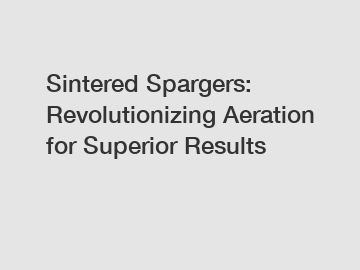Sintered Spargers: Revolutionizing Aeration for Superior Results
Sintered Spargers: Revolutionizing Aeration for Superior Results.
In the world of industrial processes that require aeration, finding the most effective and efficient method is paramount. Aeration is the process of introducing air or oxygen into a liquid, and it plays a crucial role in industries such as wastewater treatment, pharmaceutical production, and chemical processing. One technology that has been gaining popularity and revolutionizing aeration is the use of sintered spargers. In this article, we will explore the benefits and applications of sintered spargers, showcasing how they are transforming aeration for superior results.
What are Sintered Spargers?

A sintered sparger is a device that introduces gases into liquids through a porous material known as a sinter. This sintered material consists of tiny interconnected particles, allowing for precise and controlled aeration. The sparger is typically designed in the form of a tube or plate, and the sintered material is chosen based on the specific application requirements.
Enhanced Aeration Efficiency:
One of the primary benefits of using sintered spargers is their exceptional aeration efficiency. Unlike traditional spargers that introduce gases in a single, large stream, sintered spargers distribute the gases more evenly throughout the liquid. This even distribution allows for a larger surface area of gas-liquid contact, leading to improved mass transfer rates. The result is enhanced aeration efficiency, ensuring that the desired levels of oxygen or other gases are achieved effectively.
Applications in Wastewater Treatment:
Wastewater treatment facilities often face the challenge of efficiently aerating large volumes of water. Sintered spargers offer an ideal solution in such scenarios. Their uniform distribution of bubbles ensures that the dissolved oxygen levels in the wastewater are optimized for biological processes. Additionally, sintered spargers offer flexibility in terms of their design, allowing them to be easily integrated into existing treatment systems. The result is improved treatment efficiency, reduced energy consumption, and ultimately, cost savings for these facilities.
Advantages in the Pharmaceutical Industry:
In the pharmaceutical industry, aeration plays a critical role in various processes, such as fermentation and cell culture. Sintered spargers have emerged as a preferred choice over traditional sparging methods due to their ability to provide precise control over gas dispersion. This control allows for better regulation of oxygen levels and prevents oxygen toxicity, optimizing the growth and productivity of cells or microorganisms. Furthermore, the use of sintered spargers minimizes the risk of contamination, delivering superior results in pharmaceutical production.
Chemical Processing:
In the chemical industry, sintered spargers are revolutionizing processes such as gas-liquid reactions, leaching, and oxidation. By providing uniform and controlled gas dispersion, sintered spargers enhance reaction rates and improve product quality. Moreover, their robust construction using corrosion-resistant materials ensures durability, even in harsh chemical environments. The use of sintered spargers in chemical processing contributes to overall process efficiency and product consistency.
Closing:
Sintered spargers have undoubtedly revolutionized aeration in various industrial processes, offering superior results and numerous benefits. From wastewater treatment to pharmaceutical production and chemical processing, these innovative devices have proven their efficiency, reliability, and versatility. If you are looking to optimize your aeration processes and achieve superior results, contact us to explore how sintered spargers can benefit your specific application.
For more sintered element, Porous Titanium Filters, stainless steel porous filterinformation, please contact us. We will provide professional answers.


